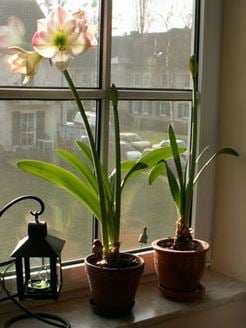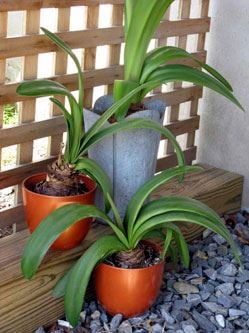Getting Amaryllis to Bloom Again
Many people wonder if you can get amaryllis bulbs to rebloom. Yes! It’s easy because amaryllis are forgiving plants.
“The flowers faded months ago, but I can’t bear to throw it out. I’d like to save it and see if I can get it to bloom again. What should I do?”
Blooming amaryllis bulbs make spectacular holiday gifts and recipients invariably want to keep the plants in hopes of a repeat performance and to honor the gift-giver. Fortunately, amaryllis are forgiving plants. All they need to bloom again is a season in the garden to replenish the bulbs. Giving the bulbs a summer vacation of fresh air, sunshine and moist, fertile soil is the best way to keep them healthy and to increase their size and flowering potential.
 Amaryllis thrive best in bright, indirect light.
Amaryllis thrive best in bright, indirect light.Immediately After Blooming
After the blossoms have faded, cut off the flowers, but leave the stalk until it withers. If any leaves have grown, leave them alone. Like other flowering bulbs, amaryllis use leaves to replenish nutrients within the bulb and fuel future growth. Treat your amaryllis like a house plant for the rest of the winter; place it in a sunny window and continue to water and feed the plant regularly with a liquid houseplant fertilizer, such as All-Purpose Organic Fertilizer.
When Warm Weather Arrives, Begin a Transition Outdoors
In spring, when the danger of frost has passed and daytime temperatures are above 50 degrees F., you can plant your bulb outdoors. It’s important to give it a slow transition to outdoor living. A couple of weeks of protected exposure to the sun and wind will prepare the bulb for life in the garden. For the first week, put the potted plant outdoors in a shady place out of the wind. If nighttime temperatures are predicted to go below 40 degrees F., bring them indoors in the evening and set them back out in the morning. In the second week, introduce them to morning sun or full exposure on cloudy days. Continue to protect the foliage from hot midday and afternoon sun. Keep the soil in the pot barely moist during this transition time.
 Amaryllis benefit from a summer outdoors. For best growth and bloom potential, remove them from pots and plant them in the ground.
Amaryllis benefit from a summer outdoors. For best growth and bloom potential, remove them from pots and plant them in the ground.A Summer Outdoors
After the transition time, it’s safe to plant the bulb in the ground. Choose a site with well-drained, fertile soil that gets four to six hours a day of morning sun and afternoon shade. Avoid hot, sunny areas. To plant the bulb in the ground, tip the plant carefully out of its pot and gently unwind any circling roots. Set the plant into the garden soil so that the neck of the bulb is an inch or two above ground. Backfill with the amended soil, firm it gently, and water thoroughly.
If wet or heavy clay soil is unavoidable, keep the amaryllis in a pot with fresh potting soil. Be sure the container has drainage holes and is deep enough to accommodate a few inches of roots beneath the bulb. Amaryllis are content in a pot and this method ensures the bulb won't rot in a waterlogged area of the garden.
Throughout the summer, protect the plant from slugs and snails. Feed with liquid fertilizer every six weeks. Keep the soil moist, but not soggy. The goal is to keep the bulb growing vigorously. Enjoy strong, green foliage, which feeds the bulb and will lead to more flower stems and buds later in the year.
 Amaryllis benefit from a summer outdoors. For best growth and bloom potential, remove them from pots and plant them in the ground.
Amaryllis benefit from a summer outdoors. For best growth and bloom potential, remove them from pots and plant them in the ground.Let Bulbs Go Dormant
In late summer, usually by mid August, stop watering and fertilizing the amaryllis plant. Force the bulb into dormancy (a "rest period"), by simulating its life cycle and signaling to the bulb that no new growth is needed. Let the foliage die back naturally, but protect it from freezing. In September — or if frost threatens — dig the bulb from the garden and plant it in a pot indoors. Trim the roots only if necessary to get the bulb into the pot. Let the soil in the pot dry out and the foliage die back. Store the bulb in a cool, dark, and dry location (a garage or basement is ideal) for a minimum of two months.
Prepare for Winter Blooms Again
About 5-8 weeks before you want the amaryllis to flower again, first repot the bulb in fresh growing mix and then give it one healthy drink of water. This initial watering triggers the plant to break dormancy and begin growing again. Once you see sprouting, increase watering and place the pot in a 60-65 degree F room with bright, indirect light.
Print this Article:
Get the Dirt
Stay up to date on new articles and advice. Please fill out the information below.

